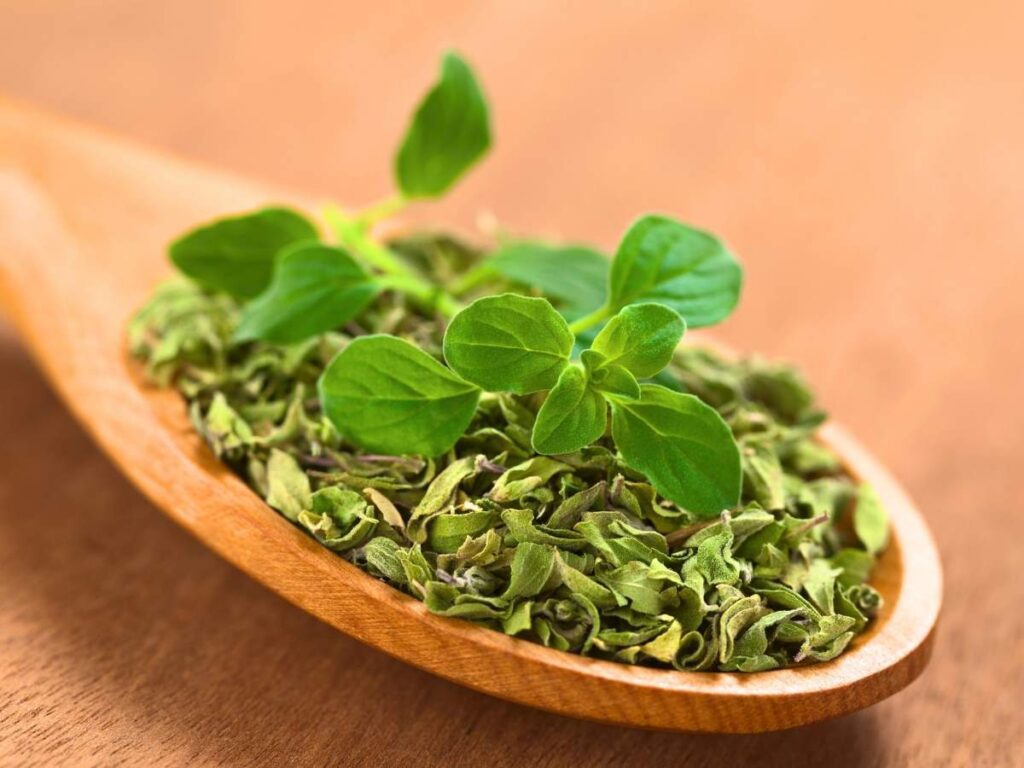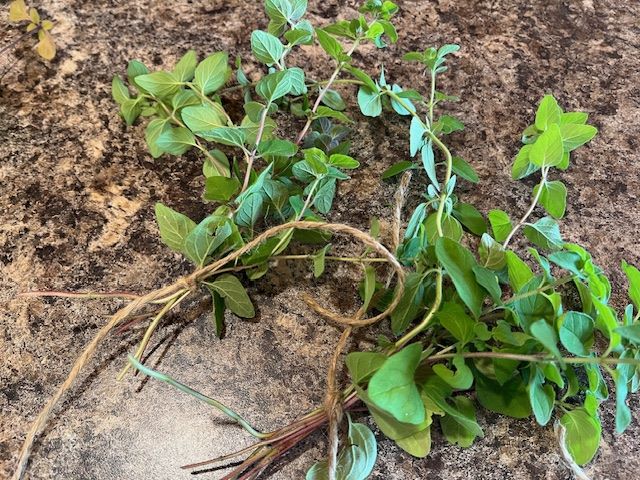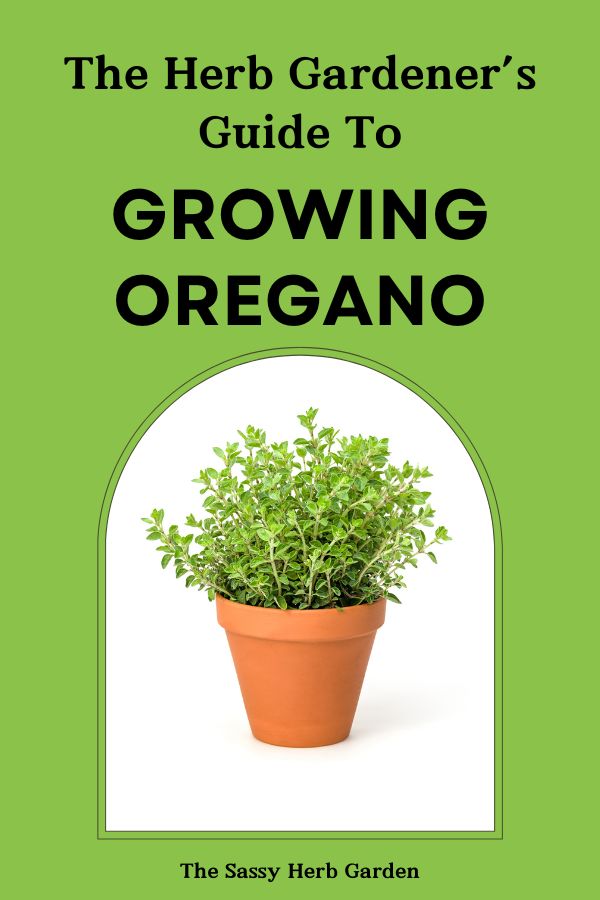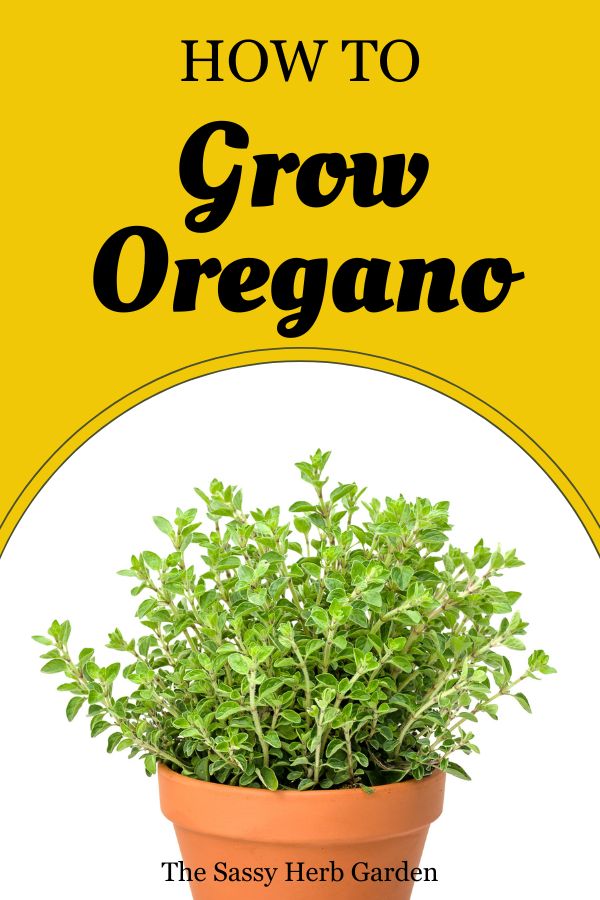Oregano is a versatile and flavorsome herb that is very easy to grow in your garden. It will reward you with an abundant supply of fresh leaves perfect for seasoning your favorite dishes. This resilient herb is a prolific grower, adding a beautiful touch of greenery to your garden. So let’s jump in and discover how to grow oregano.

Marjoram and oregano are often confused in the garden. They are from the same family, with similar appearance and growth habits. However, Origanum vulgare, often called Greek oregano is the herb you will recognize for its gorgeous flavor and aroma in your pizza sauce.
Oregano is a staple herb in many cuisines, particularly Mediterranean and Italian cooking. You can use it fresh or dried adding a unique, flavorful touch to your dishes. It pairs well with tomato-based sauces, grilled meats, and vegetables. So go ahead and experiment with cooking with oregano in your soups, sauces, and salads.

Planting and Propagation
The best way to start your new oregano plants is from cuttings. While oregano is fairly easy to grow from seed, it tends to vary genetically. That means it might not produce plants with the strong flavor we love. If you do grow from seed, buy seeds from a reputable seller, don’t use collected seeds because they have a higher risk of failing to produce a quality plant.
Growing Oregano from Cuttings: Step by Step
To grow oregano from cuttings, follow these steps:
- Select a healthy oregano plant and cut a 4-6 inch stem, preferably with some new growth.
- Remove the leaves from the bottom 2 inches of the cutting.
- Dip the bottom of the stem in a rooting hormone to improve the chances of successful rooting.
- Place the cutting in a small pot filled with moist potting mix, and ensure the pot has a drainage hole.
- Keep the cutting in a warm, bright location, and maintain consistent moisture in the soil.
- After about two weeks, the cutting should have developed roots. Transplant into a larger pot in a bright location.
Alternately, oregano cuttings also roots well in water. It takes several weeks for roots to appear so be patient and keep the water in your glass topped off. Once you have over an inch of root growth, you can move the cuttings to a small pot of moist potting mix.

Starting Oregano from Seeds: Step by Step
Start growing oregano from seeds about six to eight weeks before the expected last frost date in your area. Fill small pots or seed trays with moist, well-draining potting mix. Sprinkle the seeds over the soil surface and then lightly cover them with a thin layer of soil. Oregano seeds need some light for germination, so avoid burying them too deep.
Place the pots or trays in a warm location where the soil temperature is around 70 degrees Fahrenheit. Ensure that the soil remains moist but not saturated. Germination should usually occur within 7-14 days.
Selecting Plants from your local Garden Center
When choosing oregano plants from a garden center, look for healthy specimens with lush, green leaves and strong stems. Avoid any plants showing signs of disease or pest infestation. It is helpful to select plants that are already acclimatized to outdoor conditions, as this will make transplanting them into your garden much easier.
Transplanting Seedlings
Once the seedlings have developed at least four true leaves and the last frost date has passed, they are ready for transplanting into your herb garden. Begin by hardening off the seedlings to acclimate them to outdoor conditions. Gradually expose them to outdoor temperatures, sunlight, and wind over a week or two. Increase the time they spend outside each day.
Choose a sunny location with well drained soil. Dig a hole wide and deep enough to accommodate the seedling’s root system. Place the seedling in the hole, fill it with soil, and press down gently to eliminate any air pockets.
Remember to space the oregano plants about 12-18 inches apart to ensure adequate room for growth. Once the seedlings are planted, water them thoroughly and continue to keep the soil consistently moist as they become established.
Where to Plant Oregano in the Garden
Sunlight Requirements
Oregano thrives in areas that receive at least 6 to 8 hours of full sun every day. This will help your oregano plant develop strong, flavorful leaves. In Southern areas, where summers are very hot, a spot in the garden where you get filtered afternoon shade will reduce the stress on oregano and improve the quality of your herbs.
Preparing the Soil
When it comes to soil, oregano isn’t overly picky. Nonetheless, good soil preparation will improve the overall health and productivity of your oregano plant. Here’s how to do that:
- Choose well-draining soil: Oregano prefers well-drained soil that doesn’t hold too much water. This prevents the roots from becoming waterlogged and minimizes the risk of diseases like root rot.
- Adjust the pH: Ideally, your soil should have a pH level that falls between slightly acidic to neutral, ranging from 6.0 to 7.0. You can test your soil pH with a kit from your local garden center. If the pH is outside the ideal range, you can amend the soil to adjust it.
- Add organic matter: While oregano can tolerate poor soil, incorporating some organic matter will improve soil structure and provide essential nutrients for your plants.
Once you’ve prepared your garden bed or pot with the proper soil and sunlight conditions, you’re ready to plant your oregano.

Growing Oregano in Containers
Growing oregano in containers is a great way to enjoy this aromatic herb, whether you have an outdoor garden or want to create an indoor herb oasis. By following these simple guidelines, you’ll have fresh, flavorful oregano at your fingertips all year long.
Choosing the Best Pot
Selecting the right container is essential for your oregano plant’s growth. It should be at least 8-inches (20 cm) in diameter but I recommend a bigger pot so you don’t have to water as often. I had one on my deck in an 8 inch pot this summer and had to water it daily once it got hot. That’s a lot of commitment. Make sure you have drainage holes to prevent waterlogging. Oregano can reach a height of 18 inches (45 cm) and spread out when grown in a pot.
Indoor Tip: I had great success the last couple of winters keeping oregano in my kitchen window garden. It grew like crazy and is a perfect herb to grow indoors. However, I found I don’t use oregano fresh as often as other herbs so replaced it with a different herb this year.
Since your winter kitchen garden is usually limited in space it’s good to keep testing until you get the perfect mix. Don’t worry, I have plenty of oregano dried and frozen from our summer harvest to get me through my winter cooking sprees!
Selecting Potting Soil
Select a potting soil that is light, airy, and well-draining for the best oregano growth in containers. This will ensure your plants have the perfect environment to establish strong roots. Additionally, you can mix in perlite or vermiculite to enhance soil drainage and aeration.
Regardless of whether you’re growing oregano indoors or outdoors, be sure to place your container in a location that receives at least 6 hours of full sun each day. Oregano prefers temperatures between 60-80℉ (15-27℃) to grow at its best. If you live in a region with particularly hot summers, giving your oregano plants a bit of afternoon shade can be beneficial.

Caring for Oregano Plants
Watering
To help your oregano plants thrive, make sure they receive consistent moisture, especially during the hot summer months. Water them deeply but infrequently, allowing the soil to dry slightly between watering sessions. If growing oregano in pots, really soak the soil and then let drain well and dry out before your next watering.
Overwatering can lead to root rot, so it’s important to ensure the soil drains well. Underwatering will result in dead stems and poor growth. Monitoring the moisture level in your soils will ensure you have the most abundant growth.
Fertilizing
Oregano grows better in moderately fertile soil, so there’s no need for fertilization or addition of compost. Too much fertilization can actually make your oregano less flavorful. But, if you notice that your oregano plants seem to be struggling, a light application of organic fertilizer could be helpful.
Mulching and Pruning
Mulch well around oregano plants to retain moisture and reduce weed growth. Mulch also regulates soil temperature and provides nutrients as it decomposes.
Prune your plants regularly to promote good air circulation and encourage bushy growth. Cut back any stems that appear too woody or leggy, and remove dead leaves or flowers to prevent disease.
Overwintering
To protect your oregano plant from harsh winter conditions, after a hard frost cut back the plant to ground level and cover it with a layer of mulch. This will help keep the roots insulated from the frost. If your oregano plants are in containers, consider moving them indoors during the colder months for year-round enjoyment.
Remember to water your indoor oregano plants sparingly, allowing the soil to dry slightly before watering again. Also, ensure the plant receives enough light by placing it in a sunny windowsill or by using artificial grow lights.
Common Problems and Solutions
Common Pests
Insects are not a common problem when growing oregano. Occasionally, when a plant is under stress, you’ll find the presence of pests such as aphids and spider mites. However, it’s pretty easy to knock them off with a good spray of water. If the problem persists use an organic insecticide to clean up those pesky bugs.
Disease Management
Another problem you could face is root rot, which is more likely when oregano is grown in poorly drained soil or containers. Pruning your plants to increase air circulation and spacing out new plants can help prevent this disease. If drainage in your soil is inadequate, you might consider growing oregano in a raised bed or using containers with drainage holes.
Other Common Problems
If your oregano plants show leggy growth, it is usually caused by insufficient sunlight. Leggy growth won’t hurt oregano. However, it is a sign that your plant is not growing to the maximum of its capabilities. To avoid this, make sure your oregano receives full sun and is not planted too close to other plants. Pruning will encourage bushier growth and maintain a healthier, more attractive appearance for your oregano plants.
Remember, it is important to monitor your oregano plants regularly to quickly identify and address any problems. By doing so, you’ll be better equipped to ensure a healthy, productive herb garden.

Harvesting and Storing Oregano
When and How to Harvest
Oregano can be harvested anytime. But for the best flavor, harvest your herbs just before flowers start to bloom. To harvest oregano without killing the plant, simply snip off a few shoots about 2/3 of the way down the plant using sharp scissors. Oregano is quite tough, so you don’t need to worry about being super gentle. By trimming the plant regularly throughout the summer, you stimulate more growth and ensure a higher yield for future use in cooking.
Drying and Storing Oregano
Once you’ve harvested the fresh oregano, you can choose to dry it for longer storage or use it immediately in dishes like soups, sauces, and salad dressings. To dry your oregano, follow these steps:
- Bundle the stems together and tie them with a string.
- Hang the bundles upside down in a cool, dark, and well-ventilated area.
- Allow the oregano to dry for about 1-2 weeks, or until the leaves are crisp and easily crumble when touched.
After drying the oregano, remove the leaves from the stems and discard the stems. Store the dried oregano leaves in an airtight container, away from any direct sunlight, heat, or moisture to maintain their distinct flavor. When properly stored, dried oregano can last up to a year.
Idea: I had an abundance of dried oregano, basil, thyme, and rosemary last year so I made several small jars of “pizza herb mix” to sprinkle on pizzas and gave as gifts.
Freezing Oregano
If you like to use fresh oregano in your cooking but don’t have room to overwinter a plant, oregano freezes quite well. I just put it in a zip lock baggie, smashing out all of the air, and drop it into my deep freeze until I need it.

More Tips to Grow Oregano
Attracting Pollinators and Beneficial Insects
Oregano’s bright purple flowers are a natural attractant for pollinators which help plants in your garden to thrive, including nearby vegetables. Beneficial insects also help keep pests at bay.
Companion Planting
Companion planting can be a useful strategy to enhance the beneficial insect population in your garden. Oregano is often grown alongside vegetables to repel aphids, due to the strong aroma.
According to the Old Farmer’s Almanac, some of the best companion herbs for oregano are basil, chives, parsley, rosemary, sage, savory, and thyme because they have similar growing needs.
Frequently Asked Questions
What size pot is best for oregano?
For growing oregano in pots, choose a container that is at least 8 inches in diameter and has good drainage holes. This will provide enough space for the roots to grow and prevent waterlogging.
How quickly does oregano grow?
Oregano is a fairly fast-growing herb. Once planted, it can take around 4 to 6 weeks to establish itself and start producing leaves for harvest. With proper care, your oregano plants can grow and spread over time.
Italian vs. regular oregano?
Italian oregano (Origanum x majoricum) is a cross between sweet marjoram and common oregano. It has a milder flavor compared to regular oregano (Origanum vulgare) and is great for Italian-inspired dishes. Choose the variety that appeals to your taste preference and cooking style.
How often do you water oregano?
Oregano prefers well-drained but moist soil. To test the soil moisture, stick your index finger about an inch down into the soil. If it feels dry, it’s time to water. Avoid overwatering as this can lead to root rot.
In my kitchen garden, I tend to have a challenge with my oregano going too dry. When that happens it is not a plant that recovers well. I think it is because I like to grow it in a smaller pot so it fits in the window. This year I’m changing my potted oregano over to a much bigger container that will hold moisture while still draining well.
Is oregano a perennial plant?
Yes, oregano is a perennial plant in zone 6 up, meaning it can grow and thrive for several years. With heavy mulching you can often overwinter oregano in zones 4 and 5.
Do oregano plants spread?
Oregano plants have a low spreading habit, which makes them great groundcovers or border plants in a garden. Give them enough space to grow, as they can become quite large over time. You can also trim and prune your plants to maintain their shape and size.
Cultivating oregano can enhance both the culinary and aesthetic aspects of your garden. By following the tips and techniques outlined in this guide on how to grow oregano, you are ready for an abundance of this delicious herb in your own backyard or kitchen. The joy of harvesting fresh, aromatic oregano leaves for culinary delights awaits you. Happy gardening!

